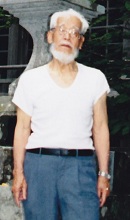


On the stone monument at Ebisu Shrine, Okikamuro we can see the engraving as follows: Names of ‘Bakan-Gumi’ boss boatman, and his crew members who donated the stone stairway, such as Yamada Yasuke and the names of the other 54 persons, as well as the year of Meiji 32, August.
The stone stairway was donated by the members of ‘Bakan-Gumi’, which should be recorded correctly without mistake.
The names engraved on Tamagaki shows those people who donated Tamagaki solely, which were built in the year of Showa 15.
In those days ‘Bakan-Gumi’ had tremendous energy and influence.
They left Okikamuro soon after Obon festival for the fishery in Shimonoseki fishing area and came back again Okikamuro from there to celebrate the October festival. After the festival they soon had to return to the Shimonoseki fishing area.
Thus they had to spend lots of days in outward and back ways in vain. ‘Bakan-Gumi’ after Obon festival held a play for a week, and then set up a festival of carrying ‘omikoshi’ (or a portable shrine), performing Sumo wrestling and competing paddle boat rowing. Many live stands were open all over the festival.
After the festival ‘Bakan-Gumi’ departed from the island, being led by the boss boatman’s boat, displaying many tairyo-bata (or good catch flags) and individual boat sign flags, with brave shouts of “Yoisho! Yoisho!”
Still remember very vividly in my mind the voice of family on the seashore who were bidding farewell, shouting and praying “Be sure to return safely!”
The scene was very rich and spectacular. Shigetoshi was a little boy, but he remembered the days very clearly. Miss those old days, which people of today in Okikamuro can hardly imagine.
Another real story was, hearing from Mr. Takeo Ohtani who lives in Okikamuro, in those days in the island there were about 80 of Young People’s Association members and about half of them i.e. 40 young men went abroad to Kaohsiung in Taiwan for work. Therefore, in October it was impossible to hold the festival with only few young men who remained in the island. Thus they determined and started to have the festival right after Obon festival while many people returned the island, which was a real story.
‘Chosen-Gumi’ boat was manned by 8 oar-rowers and its rudder hole was wide enough so that Yamada could enter. (Remember clearly that I was sent down by ropes through the rudder hole one day.)
After the Pacific War, Yamada constructed agriculture path. While devoting myself to the path construction, I widened the path, invading the field of the individuals without obtaining the owners’ consent. When the manager visited the field owners one after another in order to apologize, they replied, saying “No problem. We would like to donate the field. Our ancestors would admit for us to do so, because the field would be changed into the village path, where the villagers commute, and which would lead us to the happiness.”
People in those days put the top priority to cooperate each other for the sake of the village and for the community unification.
This was the good tradition maintained from the age of ‘Bakan-Gumi’ or older days, which was the pride of Okikamuro.
…………………………………………………………………………………………
Returning back to the story.